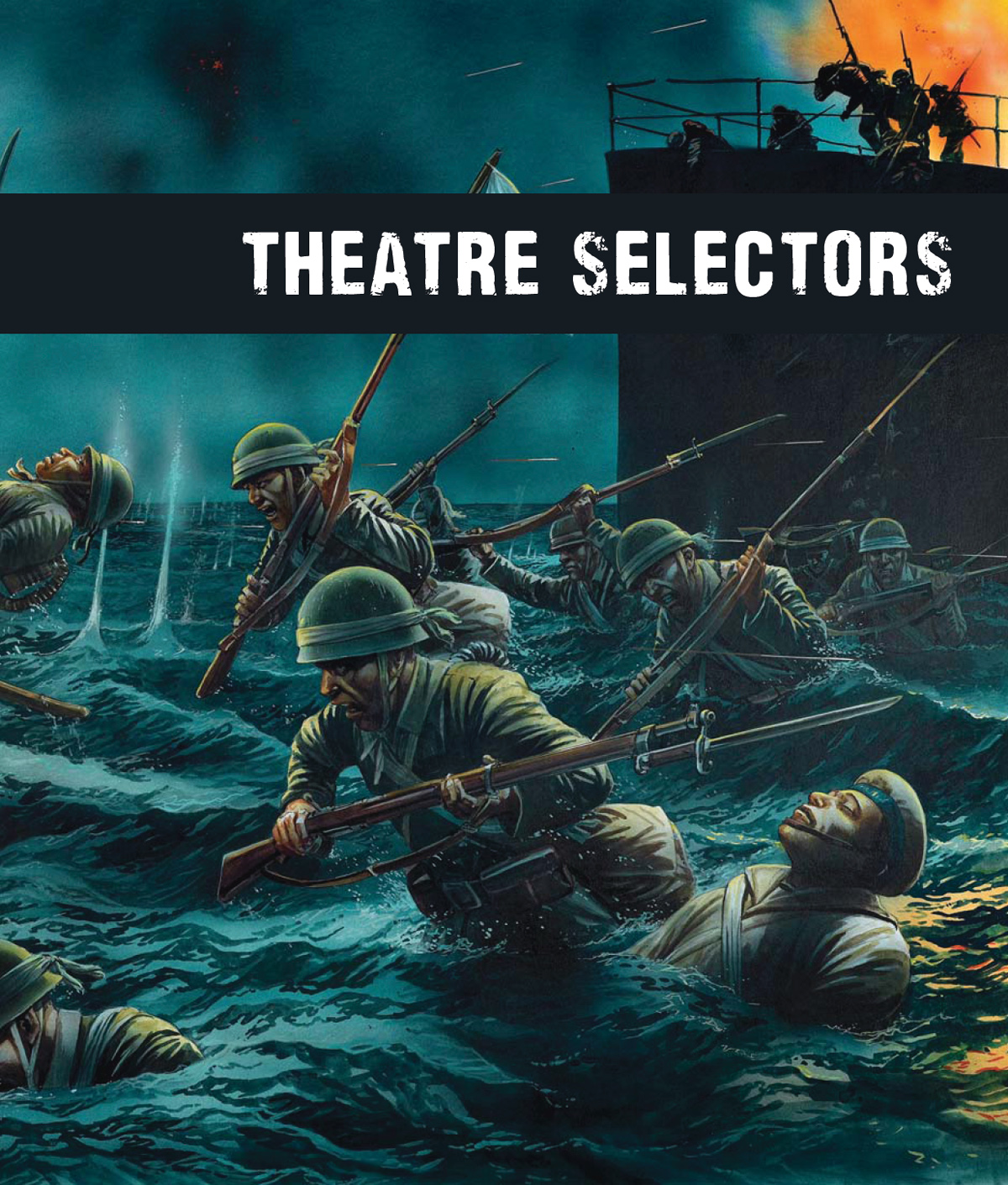

Troops of the 2nd Maizuru SNLF landing at Wake Island, by Peter Dennis © Osprey Publishing Ltd. Taken from Campaign 144: Wake Island 1941.
This section contains 12 Theatre Selectors, which we sometimes refer to simply as Selectors. Each Theatre Selector draws from the main Army List to describe a force that is broadly appropriate for a particular theatre or period of the war.
Before playing a game, the players should choose which Theatre Selector they will be using to select their reinforced platoon. If they so wish, opponents can ‘match-up’ their army lists to be contemporary with each other, so a Japanese reinforced platoon for the ‘The Battle for Guadalcanal 1942’ would be fighting a US force from ‘1942–43 Pacific’. Most of the lists could be extended to similar forces in other theatres.

For the Emperor!
Obviously, there is nothing to stop players experimenting and playing against forces from different periods and theatres. While not historically accurate, players often like to try ‘what-if’ type games. In reality, an early war IJA force from 1939 will have very little chance of facing a late-war US army for the battle of Okinawa with any hope of victory, such was the rapid development of weapons and equipment. On the other hand, the points values will ensure that such a game is fairly evenly balanced in a game of Bolt Action… but be warned – you could have trouble penetrating the armour of late-war super heavy tanks with 1939 antitank weaponry.
In 1931 the Japanese Army covertly staged an attack on a Japanese-owned railway in Manchuria, which they blamed on Chinese dissidents. The incident was then used as an excuse for a full-scale invasion of Manchuria by the IJA. This attack became known as the Mukden or Manchurian Incident.
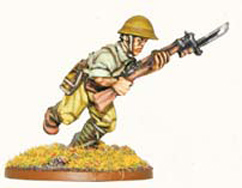
A number of IJA units were used to launch the attack from various locations along the border. The list given here is based upon the Japanese 2nd Division (Square Division) under the command of Lieutenant-General Jiro Tamon. The Division took the initial lead in the invasion and fought during the ‘Defence of Harbin.’ This operation saw the first use of Japanese armour and aircraft in and around the city of Harbin.
A Japanese force for The Invasion of Manchuria must comprise one or more Reinforced Platoons picked from the following theatre selector. Each Reinforced Platoon is made up as follows:
1 Second Lieutenant
2 IJA Infantry squads
plus:
Headquarters
0–1 First Lieutenant or Captain
0–1 Medic
0–1 Forward Observer (either Artillery or Air)
Infantry
0–4 Infantry squads: IJA Infantry, a maximum of 2 IJA Veteran Infantry squads
0–2 MMG teams
0–2 Mortar teams: light or medium
Artillery
0–1 gun from:
Anti-tank gun: Type 11 37mm (use the Type 94/Type 1 37mm anti-tank gun entry to represent these)
Artillery gun: Type 4 heavy howitzer, Type 91 105mm field gun, 75mm field gun (Type 38), Type 41 75mm mountain gun
Armoured Cars and Tankettes
0–1 Armoured car or Recce vehicle: Type 87 armoured car, Armoured railroad cars, Vickers Crossley or Wolseley armoured car (use the Type 87 armoured car entry to represent these), Type 92 tankette
Tanks, Assault Guns, Tank Destroyers and Anti-aircraft Vehicles
0–1 vehicle from: Type 89 Yi-Go medium tank, Renault FT17 ‘Ko’ light tank, Renault NC27 ‘Otsu’ light tank (use the Type 95 Ha-Go light tank entry to represent either of these Renault tanks)
Transports and Tows
0–2 vehicles from: General purpose truck, Light truck

Medium machine gun team
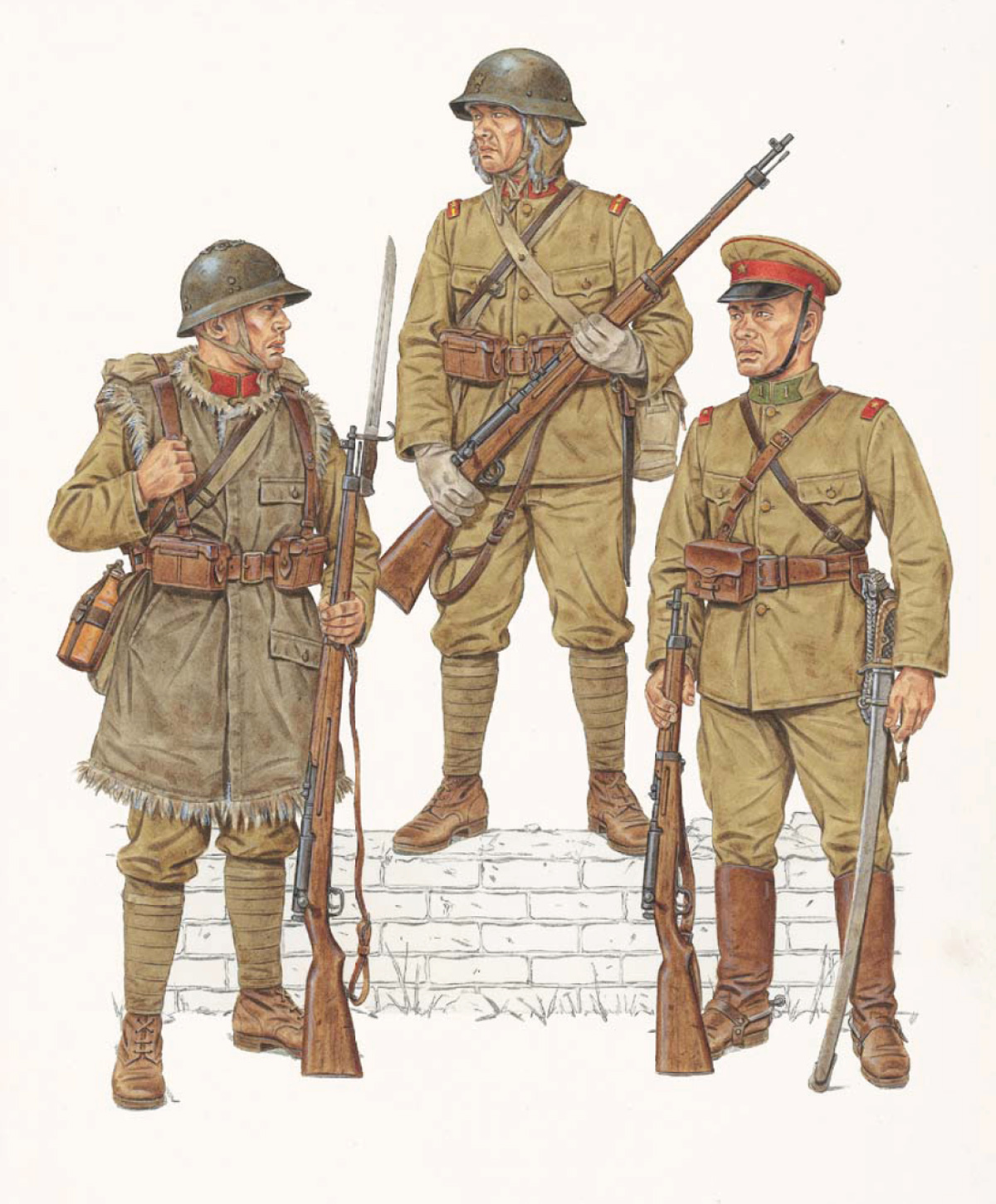
Japanese forces, Manchuria (L–R): Private 1st Class, 2nd Infantry Division; Corporal, 13th Infantry Regiment, 6th Infantry Division; Private 2nd Class, 1st Cavalry Regiment, by Stephen Andrew © Osprey Publishing Ltd. Taken from Men-at-Arms 362: The Japanese Army 1931–45 (1).
During 1942 the Japanese conquered vast new territories throughout the Pacific Ocean and South China Sea. The IJA easily overcame resistance from the mostly colonial forces stationed in these areas, securing vital oil and other resources.
The Imperial Japanese forces achieved remarkable feats of arms during the Malayan campaign, culminating in the capture of Singapore. The Japanese refer to such actions against tremendous odds as ‘Seishin’. Churchill described the British defeat as the worst disaster ever to befall the British Army. The Fall of Singapore was to provide the springboard for further conquests in the Dutch East Indies.
A Japanese force for the Fall of Singapore must comprise one or more Reinforced Platoons picked from the following theatre selector. Each Reinforced Platoon is made up as follows:
1 Second Lieutenant
2 IJA Infantry squads
plus:
Headquarters
0–1 First Lieutenant or Captain
0–1 Medic
0–1 Forward Observer (either Artillery or Air)
Infantry
0–4 Infantry squads: IJA Infantry, IJA Veteran Infantry, a maximum of 2 Regular or Veteran IJA Grenadier squads
0–2 MMG teams
0–1 Anti-tank team: anti-tank rifle team
0–1 Mortar team: light, medium or heavy
0–1 Flamethrower team
0–1 Sniper team
Artillery
0–1 gun from:
Anti-tank gun: Type 94/Type 1 37mm
Artillery gun: Type 4 heavy howitzer, Type 91 105mm field gun, 75mm field gun (Type 38 improved), Type 41 75mm mountain gun, Type 92 70mm infantry gun
Anti-aircraft gun: Type 98 20mm
Armoured Cars and Tankettes
0–1 Armoured car or Recce vehicle: Type 94 tankette
Tanks, Assault Guns, Tank Destroyers and Anti-aircraft Vehicles
0–1 vehicle from: Type 97 Chi-Ha medium tank, Type 95 Ha-Go light tank, Type 98 anti-aircraft truck
Transports and Tows
0–2 vehicles from: General purpose truck, Light truck
0–1 vehicle from: Type 98 Shi-Ke prime mover, Type 98 Ro-Ke prime mover and Type 98 So-Da carrier
The Japanese military leadership was hampered by conflicts and competition between Army generals and Navy admirals. The Army was firmly in charge of the Chinese theatre, while the Navy was leading the way in the Pacific, starting with the attack on Pearl Harbor, which launched Japan’s six-month blitzkrieg
Admiral Isoroku Yamamoto, the commander of the Japanese Navy, had spent many years in America and knew that any military success against the United States would be short-lived. As he stated himself, “I shall raise havoc for the first six months or a year, but I have utterly no confidence for the second and third years.” The Army generals were more prone to believe their own propaganda – that the Americans were a weak-spirited, decadent people, with little taste for a fight. All of this resulted in a fierce rivalry, with the Army and Navy avoiding cooperation, even if that meant fighting at a disadvantage. Usually, cooperation between the Army and Navy had to be enforced at general headquarters in Tokyo.
Ironically, this rivalry reflected the American situation, in which there was constant strife over who would be the supreme commander of the Allied forces in the Pacific war, and which required the compromise of General MacArthur being given command of the ‘Southwest Pacific’ with Admiral Nimitz commanding the ‘Central, Northern and South Pacific’.

Following the invasion of the Philippines, a number of US-held islands continued to hold out, forcing the IJA to secure these strategic positions to conclude the campaign. The island fortress of Corregidor lay to the southeast of the Bataan Peninsula. Colonel Sato’s 61st Infantry Regiment, with supporting units, was given the task of capturing the East Sector of the island.
A Japanese force for the Fall of Corregidor must comprise one or more Reinforced Platoons picked from the following theatre selector. Each Reinforced Platoon is made up as follows:
1 Second Lieutenant
2 IJA Infantry squads
plus:
Headquarters
0–1 First Lieutenant or Captain
0–1 Medic
0–2 Forward Observer (either Artillery or Air, to represent support from off-map naval artillery and carrier-borne tactical bombers)
Infantry
0–4 Infantry squads: IJA Infantry, IJA Veteran Infantry, a maximum of 2 Regular or Veteran IJA Grenadier squads
0–1 MMG team
0–1 Anti-tank team: anti-tank rifle team
0–1 Mortar team: light, medium or heavy
0–1 Flamethrower team
0–1 Sniper Team
Artillery
0–1 gun from:
Anti-tank gun: Type 94/Type 1 37mm
Artillery gun: Type 41/Type 94 75mm mountain gun, Type 92 70mm infantry gun
Anti-aircraft gun: Type 98 20mm
Tanks, Assault Guns, Tank Destroyers and Anti-aircraft Vehicles
0–1 vehicle from: Type 97-Kai Chi-Ha Shinhoto medium tank, captured M3 Stuart light tank (see the US Army Bolt Action supplement)
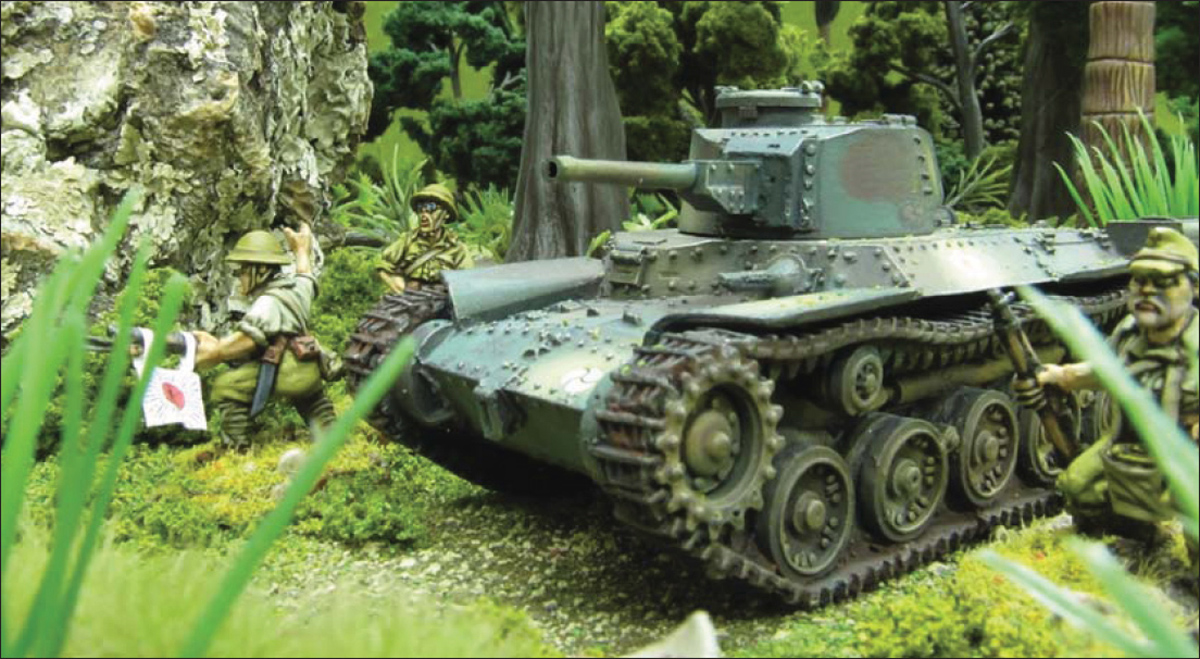
Japanese infantry edge out into a jungle clearing supported by a Shinhoto Chi-Ha
The battle for Guadalcanal marked the high point of Japanese expansion in the South Pacific before the conquerors were forced onto the defensive. Although a number of operations preceded the epic battle at Guadalcanal, the significance of this particular battle rests upon the psychological impact it had on both sides. For the Americans, it established the fighting reputation of the USMC and US Army, while dispelling the myth of Japanese invincibility. For the Imperial Japanese forces, it foretold of the extraordinary efforts that would be needed to maintain a foothold in the South Pacific.
Although there were a number of Navy and Army units on the island, this list represents the IJA forces present at Guadalcanal.
A Japanese force for Guadalcanal must comprise one or more Reinforced Platoons picked from the following theatre selector. Each Reinforced Platoon is made up as follows:
1 Second Lieutenant
2 IJA Infantry squads
plus:
Headquarters
0–1 First Lieutenant or Captain
0–1 Medic
0–1 Forward Observer (either Artillery or Air)
Infantry
0–4 Infantry squads: IJA Infantry, IJA Veteran Infantry, a maximum of 1 Regular or Veteran IJA Grenadier squad
0–2 MMG teams
0–1 Anti-tank team: anti-tank rifle team
0–1 Mortar team: light, medium or heavy
0–1 Flamethrower team
0–2 Sniper teams
Artillery
0–1 gun from:
Anti-tank gun: Type 94/Type 1 37mm
Artillery gun: Type 41/Type 94 75mm mountain gun, Type 92 70mm infantry gun, 75mm field gun (Type 38 improved)
Anti-aircraft gun: Type 98 20mm
Tanks, Assault Guns, Tank Destroyers and Anti-aircraft Vehicles
0–1 vehicles from: Type 97 Chi-Ha medium tank, Type 95 Ha-Go light tank
Transports and Tows
0–2 vehicles from: General purpose truck, Light truck
0–1 vehicle from: Type 98 Ro-Ke prime mover

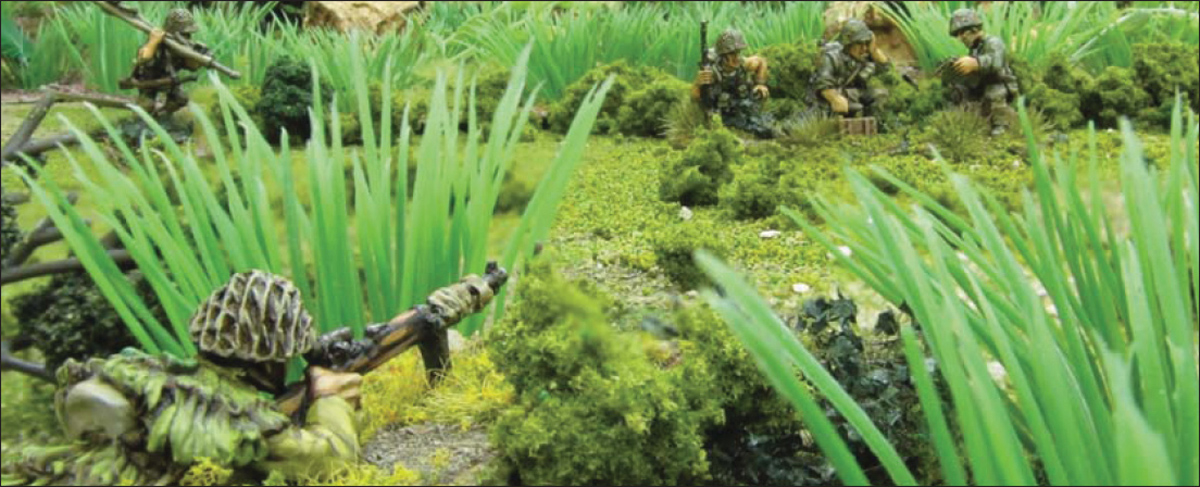
Sniper! US Marines come under fire
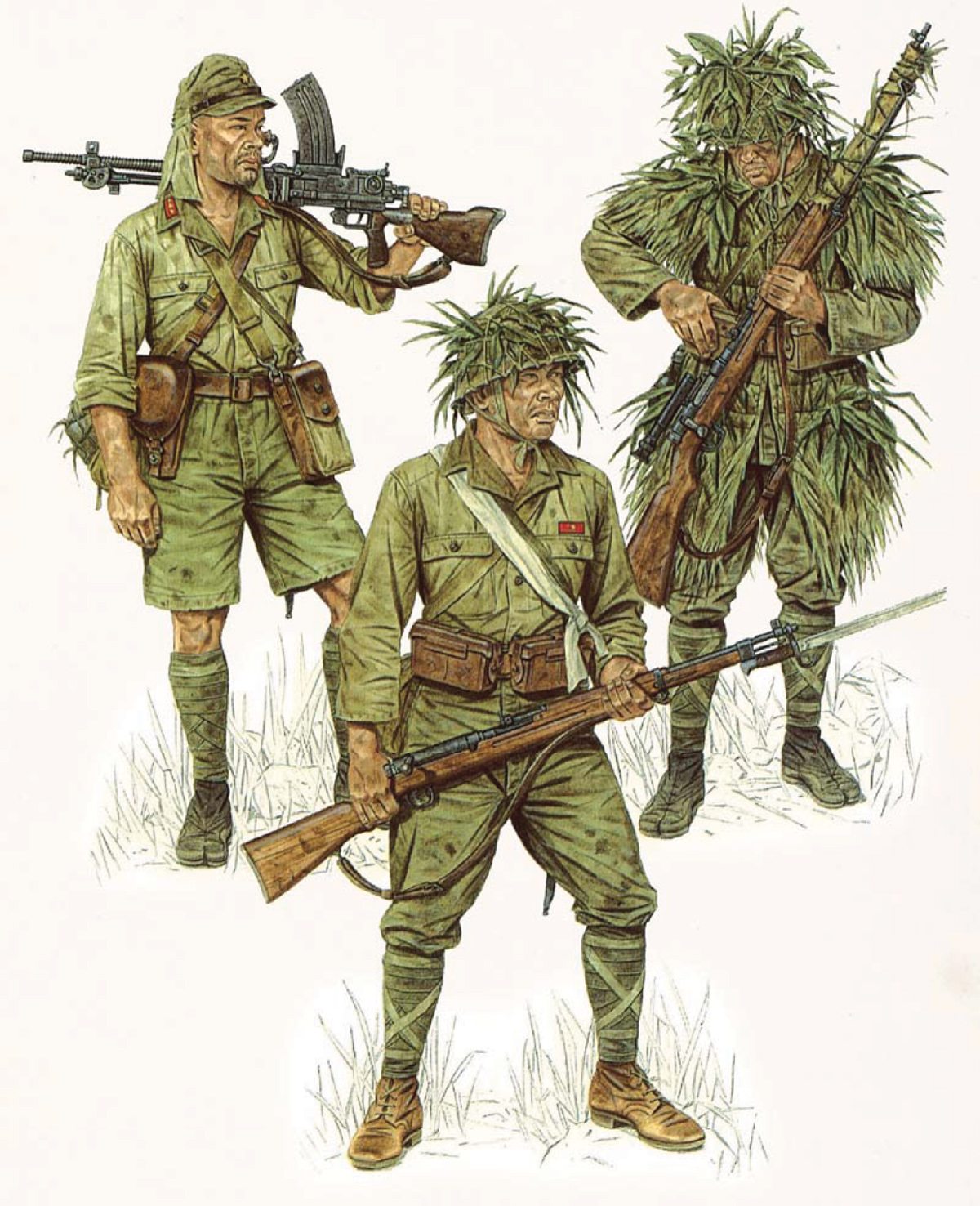
Japanese forces, Solomons and New Guinea (L–R): Superior Private, 20th Infantry Division, New Guinea; Private 2nd Class, 2nd Infantry Division, Guadalcanal; Sniper, 124th Infantry Regiment, Guadalcanal, by Stephen Andrew © Osprey Publishing Ltd. Taken from Men-at-Arms 369: The Japanese Army 1931–45 (2).
The Japanese mounted a number of successful land and air campaigns prior to this battle, but the airborne assault on Palembang, alongside other operations in January and February 1942, most effectively shows the Japanese use of airborne troops to achieve their initial tactical goals. In this case, almost 300 men of the 2nd ‘Teishin Shudan’ regiment were dropped to capture an airfield and an oil refinery complex near Palembang, in preparation for a large amphibious assault.
There were a number of Navy paratroop operations in the Dutch East Indies prior to this mission. This list is based upon the IJA Teishin Shudan paratroopers who took part in operations at Palembang.
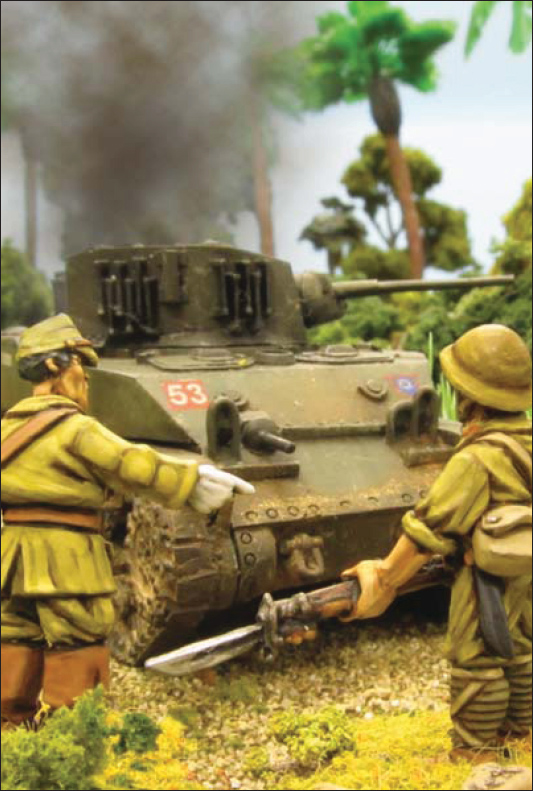
A Japanese commander surveys the aftermath of successful encounter with British forces
An IJA paratroop force for Palembang must comprise one or more Reinforced Platoons picked from the following theatre selector. Each Reinforced Platoon is made up as follows:
1 First Lieutenant
2 IJA Teishin Shudan paratrooper squads
plus:
Headquarters
0–1 Major
0–1 Medic
0–1 Forward Observer (Air)
Infantry
0–4 Infantry squads: Teishin Shudan paratroopers, a maximum of 1 Veteran IJA Grenadier squad
0–1 MMG team
0–1 Anti-tank team: anti-tank rifle team
0–1 Mortar team: light
0–1 Flamethrower team
0–1 Sniper team
Artillery
0–1 gun from:
Anti-tank gun: Type 94/Type 1 37mm
Transports
0–1 Captured Dutch truck (use either the General purpose truck or Light truck entry to represent this)
In the Japanese armed forces, paratroops were not confined to the IJA, the IJN also included paratroop regiments, and the two services competed for the airborne role. The Yokosuka 1st and 3rd SNLF were trained as airborne units for future operations.
The first operation involving the Rikusentai (SNLF) paratroopers was the airborne assault upon the airfield at Langoan, near Menado Township in northern Celebes. They landed in conjunction with amphibious landings by other SNLF forces in the vicinity.
An IJN paratroop force for Menado must comprise one or more Reinforced Platoons picked from the following theatre selector. Each Reinforced Platoon is made up as follows:
1 Second Lieutenant
2 SNLF Rikusentai paratrooper squads
plus:
Headquarters
0–First Lieutenant or Captain
0–1 Medic
0–1 Forward Observer (Air)
Infantry
0–4 Infantry squads: Rikusentai paratroopers, a maximum of 2 SNLF renadier squads
0–1 MMG team
0–1 Mortar team: light
0–1 Flamethrower team
Artillery
0–1 gun from:
Anti-tank gun: Type 94/Type 1 37mm
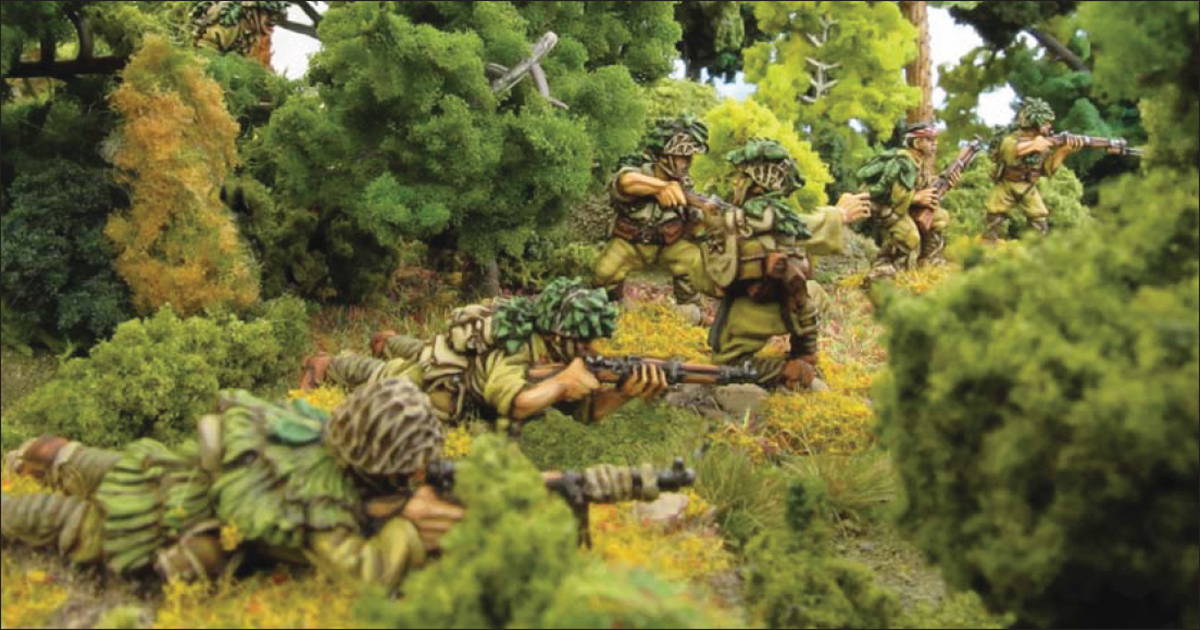
The Emperor’s loyal soldiers stalk the jungle...
The Special Naval Landing Force (SNLF) was given the task of defending Betio Atoll and the surrounding outer islands against the US 2nd Marine Division. For the US Marines launching their amphibious assault against the Japanese-held island it was to be a bloody baptism of fire. Casualties were so high that the battle resulted in changes to US tactics for the remainder of the island-hopping campaign in the Pacific.
A Japanese force for the battle of Tarawa must comprise one or more Reinforced Platoons picked from the following theatre selector. Each Reinforced Platoon is made up as follows:
1 Second Lieutenant
2 SNLF squads
plus:
Headquarters
0–1 First Lieutenant or Captain
0–1 Medic
0–1 Forward Observer (Artillery)
Infantry
0–4 Infantry squads: SNLF Squad, a maximum of 1 SNLF Grenadier squad
0–2 MMG teams
0–2 anti-tank teams: anti-tank rifle team, suicide anti-tank team
0–2 Mortar teams: light, medium or heavy
0–3 Sniper teams
Artillery
0–1 gun from:
Anti-tank gun: Type 94/Type 1 37mm
Artillery gun: Type 92 70mm
infantry gun Anti-aircraft gun: Type 98 20mm
Tanks, Assault Guns, Tank Destroyers and Anti-aircraft Vehicles
0–2 vehicles from: Type 95 Ha-Go light tank, Type 2 Ka-Mi light amphibious tank
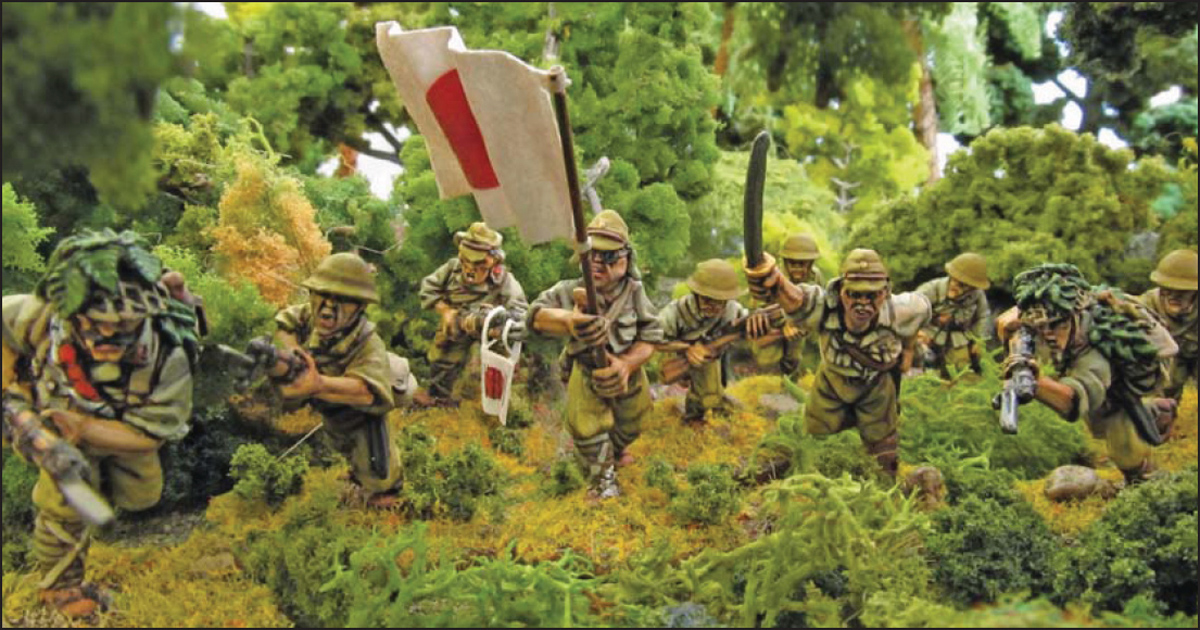
A Japanese unit charges with sword and bayonet
Japan’s abortive ‘March on India’ left the IJA on the defensive and marked the beginning of the end of Japan’s iron grip on Burma. The Burma campaign was see some of the most determined fighting of the Pacific War, and was to take the greatest toll upon Japanese lives of the whole war.
A Japanese force for Burma 1944 must comprise one or more Reinforced Platoons picked from the following theatre selector. Each Reinforced Platoon is made up as follows:
1 Second Lieutenant
2 IJA Infantry squads
plus:
Headquarters
0–1 First Lieutenant or Captain
0–1 Medic
0–1 Forward Observer (either Artillery or Air)
Infantry
0–4 Infantry squads: IJA Infantry, IJA Veteran Infantry, a maximum of 1 Bamboo Spear Fighter squad (note that Infantry and Veteran Infantry squads can be dual-weapon squads, see page 22)
0–2 MMG teams
0–1 Anti-tank team: anti-tank rifle team, suicide anti-tank team
0–2 Mortar teams: light, medium or heavy
0–2 Sniper teams
0–1 Flamethrower teams
Artillery
0–1 gun from:
Anti-tank gun: Type 94/Type 1 37mm, Type 1 47mm
Artillery gun: Type 4 heavy howitzer, Type 91 105mm field gun, 75mm field gun (Type 90, Type 38 improved), Type 41 75mm mountain gun, Type 92 70 mm infantry gun
Anti-aircraft gun: Type 98 20mm
Armoured Cars and Tankettes
0–1 Armoured car or Recce vehicle: Type 97 Te-Ke tankette
Tanks, Assault Guns, Tank Destroyers and Anti-aircraft Vehicles
0–1 vehicle from: Type 97-Kai Shinhoto Chi-Ha medium tank, Type 95 Ha-Go light tank, captured M3 Stuart light tank (see the US Army Bolt Action supplement), and Type 1 Ho-Ni tank destroyer, Type 98 anti-aircraft truck
Transports and Tows
0–2 vehicles from: General purpose truck, Light truck, Type 95 Kurogane
0–1 vehicle from: Type 98 Shi-Ke prime mover, Type 98 Ro-Ke prime mover and Type 98 So-Da carrier
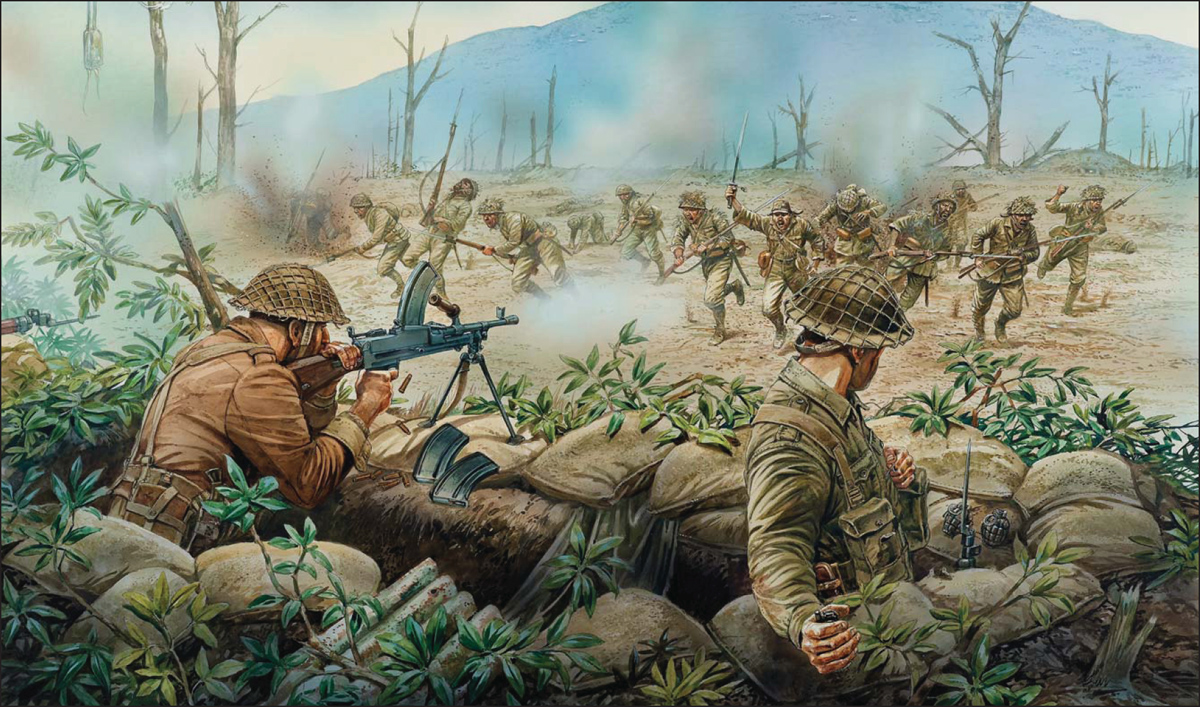
British Bren gun team facing a Japanese banzai charge, by Peter Dennis © Osprey Publishing Ltd. Taken from Campaign 229: Kohima 1944.
Allied troops were shocked by the devotion and fanaticism of the Japanese soldier. The early war victories of the seemingly unbeatable Japanese painted a picture of a supreme soldier and natural jungle fighter – despite the fact that most Japanese had never seen a jungle until they joined the army. During the fighting on Guadalcanal, the Allies realised that they faced an enemy with a very different mindset to their own. It was observed that Japanese troops frequently attacked in hopeless situations instead of surrendering as western soldiers would.
The Japanese soldier came from a culture that rewarded conformity, stoic obedience and spiritual devotion to the Emperor. The Japanese military doctrine, because it did not recognize surrender as an option, gave Japanese troops caught in an indefensible situation little choice but to attack and die. Thus, the Japanese would simply form up and make a suicidal banzai charge against their enemies. While always an impressive display of spirit, it was no protection from bullets, bombs or shells.
Iwo Jima is located in the Nampo Archipelago (also known as the Volcanic Islands). It was of strategic importance to both sides. For the Japanese it formed a key link the outer defences of Japan itself. For the Allies it would provide the essential base from which the war against the Japanese mainland would be launched. The IJA sent Lieutenant General Kuribayashi to take command of the defences on Iwo Jima – a desperate mission to provide valuable time for the Japanese to build up their defensive systems on the mainland.
Whilst there were a number of Navy and Army units on the island, the following list represent the IJA forces present at Iwo Jima.
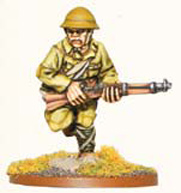
A Japanese force for Iwo Jima 1945 must comprise one or more Reinforced Platoons picked from the following theatre selector. Each Reinforced Platoon is made up as follows:
1 Second Lieutenant
2 IJA Infantry squads
plus:
Headquarters
0–1 First Lieutenant or Captain
0–1 Medic
0–1 Forward Observer (Artillery)
Infantry
0–4 Infantry squads: IJA Infantry, IJA Veteran Infantry, up to a maximum of 2 IJA Island Warfare Rifle squads (note that Infantry and Veteran Infantry squads can be dual-weapon squads, see page 22)
0–2 MMG teams
0–2 anti-tank teams: anti-tank rifle team, suicide anti-tank team
0–2 Mortar teams: light, medium or heavy
0–2 Sniper teams
Artillery
0–1 gun from:
Anti-tank gun: Type 94/Type 1 37mm, Type 1 47mm
Artillery gun: 75mm field gun (Type 90, Type 38 improved), Type 41 75mm mountain gun, Type 92 70mm infantry gun
Anti-aircraft gun: Type 98 20mm
Tanks, Assault Guns, Tank Destroyers and Antiaircraft Vehicles
0–1 vehicle from: Type 97 Chi-Ha medium tank, Type 97-Kai Shinhoto Chi-Ha medium tank, Type 95 Ha-Go light tank
Transports and Tows
0–2 vehicles from: General purpose truck, Light truck, Type 95 Kurogane

Type 97 Chi-Ha medium tank

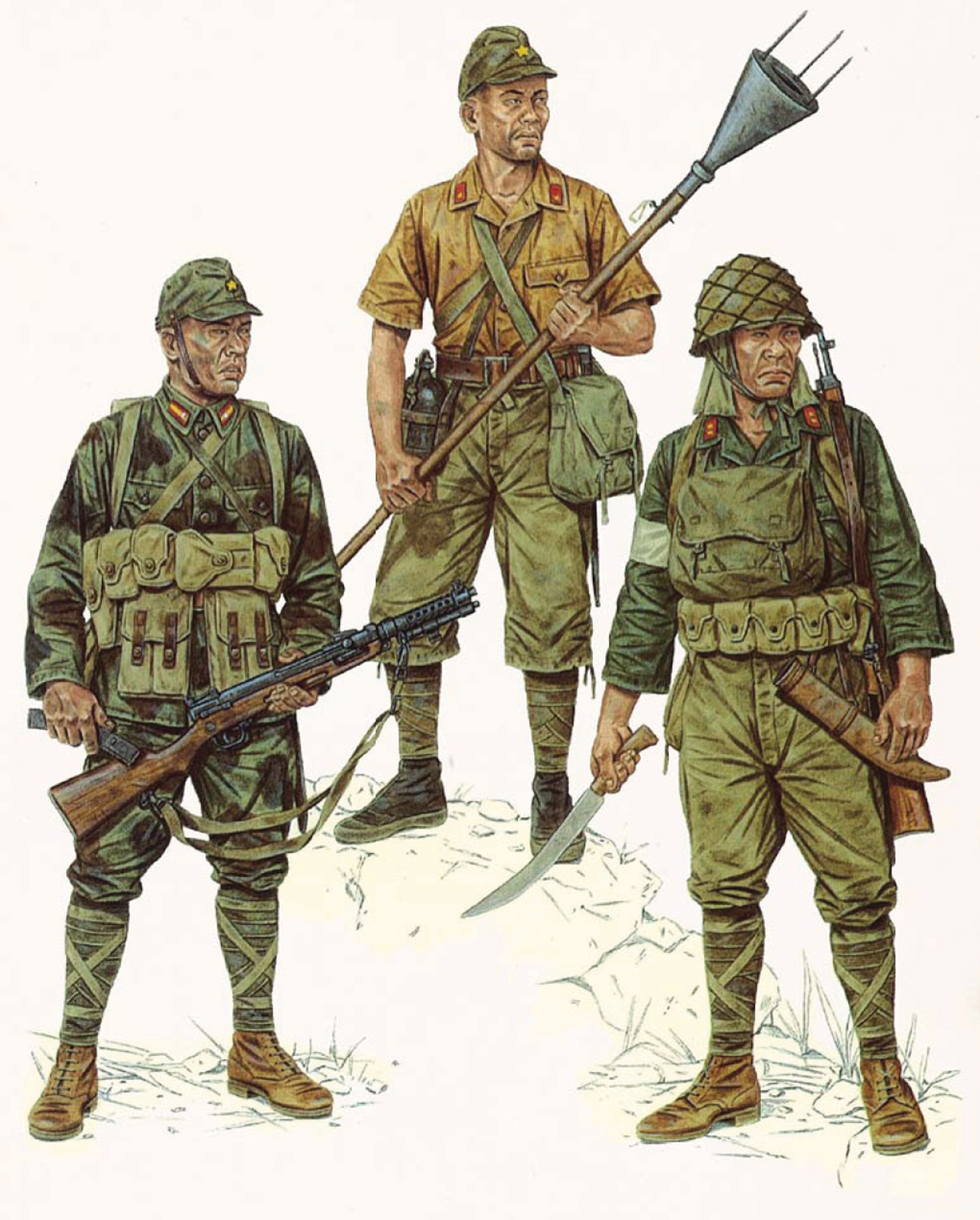
Japanese forces, Pacific Defence (L–R): Corporal, Giretsu units, Okinawa; Private 2nd Class, 109th Infantry Division, Iwo Jima; Private 1st Class, 1st Takasago Raiding Company, Leyte, by Stephen Andrew © Osprey Publishing Ltd. Taken from Men-at-Arms 369: The Japanese Army 1931–45 (2).
Elements of the 2nd Raiding Brigade were sent to Bacolod airfield on Negros Island in anticipation of a US landing. Together with elements of the Japanese 77th IJA Infantry Brigade, the mixed Japanese force initially undertook guerrilla operations against the invaders, before going on the defensive. The US 40th Infantry Division was later reinforced by the 503rd Parachute Infantry Regiment, and it was this regiment that was involved in a firefight with their opposing airborne counterparts.
An IJA force for Negros Island must comprise one or more Reinforced Platoons picked from the following theatre selector. Each Reinforced Platoon is made up as follows:
1 First Lieutenant
2 IJA Teishin Shudan paratrooper squads
plus:
Headquarters
0–1 Captain or Major
0–1 Medic
0–1 Forward Observer (Artillery)
Infantry
0–4 Infantry squads: IJA Teishin Shudan paratroopers, IJA Infantry, IJA Veteran Infantry, up to a maximum of 2 IJA Island Warfare Rifle squads (note that Infantry and Veteran Infantry squads can be dual-weapon squads, see page 22)
0–2 MMG teams
0–1 Anti-tank team: anti-tank rifle team, suicide anti-tank team
0–1 Mortar team: light, medium or heavy
0–2 Sniper teams
Artillery
0–1 gun from:
Anti-tank gun: Type 94/Type 1 37mm, Type 1 47mm
Artillery gun: Type 92 70mm Infantry Gun
Anti-aircraft gun: Type 98 20mm
Many Japanese soldiers were not to learn of the end of the war for many months after Japan’s surrender, and some refused to believe it, attributing all attempts to convince them otherwise to enemy propaganda. A few continued to wage a guerrilla war from the jungles for years, but by the 1970s the Japanese believed that all the soldiers left behind in this way had long since either surrendered or died. This was not quite true, however – there was one soldier who continued to fight his one-man war against the occupiers, and his name was Hiroo Onada.
Onada was an Imperial Army Intelligence officer, trained in guerrilla warfare and assigned to Lubang in the Philippines. His orders were to remain on the island no matter what, until the Japanese returned. “It may take three years, it may take five, but whatever happens, we’ll come back for you,” promised his commanding officer, Major Taniguchi. As it turned out it took 29 years!
When the Americans overran Lubang, surviving Japanese soldiers broke into small groups and took to the jungles and mountains. They continued to fight on, waging a guerrilla war and gathering intelligence, preparing for the return of the Japanese Army to liberate the island. Although the Americans dropped leaflets and newspapers from aircraft in an effort to convince surviving fighters the war really was over, Onada and his comrades refused to believe it. As far as they were concerned it was inconceivable that Japan could have lost the war at all – let alone so soon. These efforts to draw the Japanese soldiers from the jungles continued for many years.
In 1972, long after the authorities had written off all these Japanese soldiers as dead, the last of Onada’s companions was killed in a skirmish with a Filipino patrol. This alerted them to the possibility that Onada himself was still alive, but all attempts to find him came to nothing: he was far too skilled in jungle warfare to allow himself to be captured. However, in 1974 he was tracked down, by a student called Nario Susuki. Nario had heard Onada’s story and was determined to bring him home. But although he spoke with Onada he was unable to convince the Japanese soldier to surrender. Onada would continue to obey the order given to him by Major Taniguchi, until relieved as promised.
By good fortune Major Taniguchi had survived the war and was able to return to Lubang and order Onada to surrender. And so, in March 1975 Onada donned his uniform and formally surrendered to President Marcos of the Philipinnes, who officially pardoned him for the damage and deaths inflicted during his years of armed resistance.
Onada returned home where he found a different kind of Japan to the one he had known. He was not entirely impressed by his country’s newfound role in the world, and was horrified by the lack of discipline and pride amongst the younger Japanese. He went to live in Brazil.
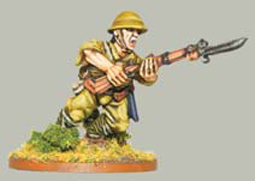
Sugar Loaf Hill is a small feature situated on the southern end of Okinawa. The island itself formed part of the triangular defensive network intended to prevent the American forces from reaching the Kiyan peninsula. The 44th Independent Mixed Brigade’s 15th Independent Mixed Regiment, under Major General Suzuki Shigeki, with attached Japanese forces from various Army units, was ordered to defend the area against the Sixth US Marine Division. The ensuing battle was extremely costly for both sides.
A Japanese force for Sugar Loaf Hill 1945 must comprise one or more Reinforced Platoons picked from the following theatre selector. Each Reinforced Platoon is made up as follows:
1 Second Lieutenant
2 IJA Infantry squads
plus:
Headquarters
0–1 First Lieutenant or Captain
0–1 Medic
0–1 Forward Observer (Artillery)
0–1 Kempeitai Political Officer
Infantry
0–4 Infantry squads: IJA Infantry, IJA Veteran Infantry, a maximum of 2 IJA Island Warfare Rifle squads, a maximum of 2 Bamboo Spear Fighter squads, a maximum of 2 Militia squads (note that Infantry and Veteran Infantry squads can be dual-weapon squads, see page 22)
0–2 MMG teams
0–2 Anti-tank teams: anti-tank rifle team, suicide anti-tank team
0–2 Mortar teams: light, medium or heavy
0–2 Sniper teams
Artillery
0–1 gun from:
Anti-tank gun: Type 94/Type 1 37mm, Type 1 47mm
Artillery gun: Type 92 70mm infantry gun, Type 41 75mm mountain gun
Anti-aircraft gun: Type 98 20mm

Sniper with Arisaka rifle on monopod

Japanese NCO’s sword
The Japanese forces on Okinawa had defended the island doggedly since the American invasion. The Japanese commanders were tired and frustrated, and wanted to strike back at the US forces. General Ushijima ordered the 32nd Army to attack as planned on 4 May 1945.
The counter-offensive of General Amamiya’s 24th Division was supported by the 27th Tank Regiment under the command of Colonel Kanayama. In addition, the 24th Reconnaissance Regiment belonging to the 24th Division was equipped with seven Type 94 tankettes.
A 24th Division counter-offensive force must comprise one or more Reinforced Platoons picked from the following theatre selector. Each Reinforced Platoon is made up as follows:
1 Second Lieutenant
2 IJA Infantry squads
plus:
Headquarters
0–1 First Lieutenant or Captain
0–1 Medic
0–1 Forward Observer (Artillery)
Infantry
0–4 Infantry squads: IJA Infantry, IJA Veteran Infantry, a maximum of 2 IJA Island Warfare Rifle squads (note that Infantry and Veteran Infantry squads can be dual-weapons squads, see page 22)
0–2 MMG teams
0–1 Anti-tank team: anti-tank rifle team, suicide anti-tank team
0–1 Mortar team: light, medium or heavy
0–1 Sniper team
Artillery
0–1 gun from:
Anti-tank gun: Type 94/Type 1 37mm, Type 1 47mm
Artillery gun: Type 92 70mm infantry gun, Type 41 75mm mountain gun, Type 38 (improved) 75mm field gun
Anti-aircraft gun: Type 98 20mm
Armoured Cars and Tankettes
0–1 Armoured car or Recce vehicle: Type 94 tankette
Tanks, Assault Guns, Tank Destroyers and Anti-aircraft Vehicles
0–1 vehicle from: Type 97 Shi-Ki command tank, Type 97 Chi-Ha medium tank, Type 1 Chi-He medium tank, Type 3 Ka-Chi medium amphibious tank, Type 95 Ha-Go light tank, Type 98 Ke-Ni light tank, Type 3 Ho-Ni III tank destroyer, Type 4 Ho-Ro assault gun, Type 98 anti-aircraft truck
Transports and Tows
0–2 vehicles from: General purpose truck, Light truck, Type 95 Kurogane, Type 1 Ho-Ha half-track, Type 1 Ho-Ki carrier
0–1 vehicle from: Type 98 Shi-Ke prime mover, Type 98 Ro-Ke prime mover and Type 98 So-Da carrier
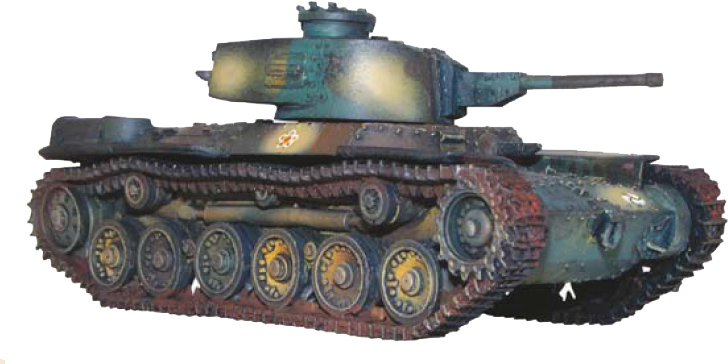
Type 97 Shinhoto Chi-Ha medium tank